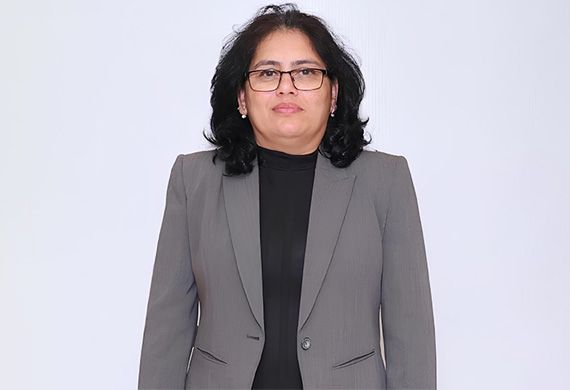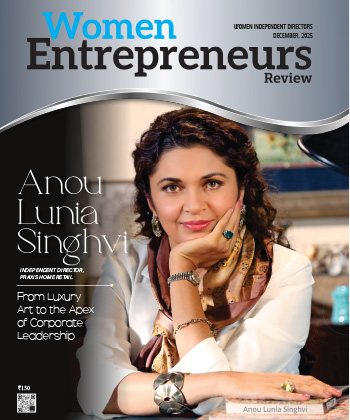
The Architecture of Equality: Designing Spaces Where Women Lead
By: Pallavi Matkari, Head- Architecture & Interior Design, Reliance Industries Limited
With over three decades of experience, Pallavi Matkari, Head- Architecture & Interior Design at Reliance Industries Limited, has built a distinguished career at the intersection of creativity, strategy, and leadership. Her work spans architecture, academia, NGO collaborations, and corporate management, reflecting a holistic approach to design. Having led projects across hospitality, retail, institutional, and commercial sectors, she continues to redefine how architectural innovation can seamlessly align with business strategy and user experience.
In an engaging conversation with Women Entrepreneurs Review Magazine, Pallavi takes us on a journey through her experience as a business leader, sharing a unique perspective from the gender-lens.
Touching upon key themes, she shares her perspectives on the evolving role of women in the field of architecture. She shares anecdotes regarding leading large-scale corporate design initiatives, standing her ground when tough decisions had to be made and more.
To know more about Pallavi Matkari’s impactful journey in architecture and her thoughts on leadership, read the following interview.
Reflecting on your journey, how did early experiences shape your sense of purpose? Were there moments that quietly nudged you towards leadership?
I began my career as an architect in 1996, at a time when gender often shaped expectations in subtle ways, and unspoken perceptions still influenced how one’s role was viewed within the profession. Women were often seen as better suited for the “softer” aspects of design, interiors, landscaping, or aesthetics, while men handled the technical and on-site work.
Growing up in a ‘defence family’ taught me to question norms and take responsibility for driving change. I have never believed that gender defines capability; capability is simply capability. That conviction has guided every step of my career.
At a crucial point, I had to choose between starting my own practice or joining a larger organization to create impact from within. I chose the latter, determined to influence systemic change and redefine spaces where women could lead with confidence, creativity, and purpose, even if it meant beginning with small but meaningful steps.
As your path unfolded, how did uncertainty test that purpose? What inner strengths helped you navigate challenges while staying true to your convictions?
In architecture, balancing creativity with practicality is always a challenge.
You can have the most brilliant, out-of-the-box idea, but if it isn’t logical or feasible, you must have the foresight to step back and rework on it.
For me, design has always been about finding that equilibrium between innovation and function, aesthetics and purpose.
Two principles I hold close are curiosity and integrity of thought. I believe every decision in design shapes how people experience a space, and that demands both honesty and courage. Often, it means standing by an unconventional choice, a material, a detail, even when it isn’t the easiest or most popular path. At times, such stands come at a cost, perhaps slower recognition or missed opportunities, but the respect earned through integrity lasts much longer than any short-term reward.
Decisions grounded in honesty and logic may face resistance initially, but eventually, they earn validation. For me, that’s what defines meaningful design and meaningful leadership.
You speak about courage in taking unconventional stands. Can you share a moment where standing firm changed the trajectory for your team or community?
I once found myself in a challenging situation where a project had to be completed within a tight deadline and budget as it was the venue for a major global conference. We had specified a handcrafted wooden light fitting from overseas — an expensive choice, but one that was truly unique and became the focal point of the design. I was convinced it would define the entire space, but our MD insisted I replace it with a cheaper local option. I told him I couldn’t convince others of something I didn’t believe in, and asked for a day to rethink. I re-evaluated the design, substituted a few materials with local alternatives, and freed up funds for the light without exceeding the budget.
The result was stunning. When the MD saw it lit up the night before the event, he admitted it was the right decision. That experience reinforced my belief that courage, conviction, and practical thinking can turn a vision into reality.
Innovation often means authenticity over spectacle. How do you encourage women in your team to bring their genuine ideas forward without fear or hesitation?
From a young age, I was drawn to philosophy and psychology, which both taught me how deeply human behaviour shapes creativity and leadership. One thing I realized early on is that the fear of judgment kills curiosity. People often hesitate to ask questions, worried they will sound silly. To break that barrier, I make it a point to say, “Can I ask a silly question?” It lightens the room and signals that no question is off-limits.
When I lead teams, I ensure everyone has a voice. I don’t believe in being the only one speaking; every person brings unique experiences and perspectives. I encourage people to talk about problems and possible solutions, which builds ownership and confidence.
Leadership for me isn’t about hierarchy but about creating a space of authenticity, openness, and psychological safety, where fear is replaced by curiosity and people can think, question, and perform freely.
How do you balance personal ambitions with nurturing teams and creating spaces where women can truly belong?
I have never believed in pulling someone down to rise higher. For me, true growth happens when we uplift others and move forward together. I think it’s important to maintain a balance between the head and the heart. The mind brings clarity and practicality, while the heart brings empathy and intuition. Women naturally possess that emotional intelligence, and when combined with logic, it creates balanced, inclusive workplaces.
Within my teams, I encourage women to define success on their own terms. It’s perfectly fine to be ambitious, and equally fine to be content. But whatever you choose, own it fully.
I also believe equality isn’t about competing against men; it’s about standing alongside them as equals. That means putting in the same effort, taking on the same challenges, and expecting the same standards. Real equality doesn’t come from asking for concessions, but from proving through action that we belong at the same table as true equals.
LAST WORD: Advice For Aspiring Women Leaders on Building Resilience, Authenticity & Impact
To me, success should never be defined by someone else’s standards. Each one of us needs to look inwards, cut through the noise, and understand what truly matters to us. That’s where real success lies. It’s a deeply personal feeling, not something measured by external validation.
Resilience is what we are born with, and authenticity is what defines who we are. When these two come together, the impact we create becomes our true legacy. That’s the kind of success I believe in, one that’s honest, self-driven, and lasting.
Today, women are in a powerful position to shape the foundation of a more equitable and empathetic workforce. By leading with authenticity and resilience, we are not just breaking barriers; we are building the framework for what leadership will look like in the future.
Most Viewed
- 1 Women's Health Startup HerMD Closing Doors Amid Industry Challenges
- 2 5 Famous Women in Indian Armed Forces
- 3 Saudi Women No longer Require Male Permission for Clothing Choices, says Prince MbS
- 4 Kolkata Medtech Startup Innovodigm Raises Rs 5.5 Crore Seed Funding Led by IAN Group
- 5 Yamunanagar's Kashish Kalra Honoured after Securing 111th Rank in UPSC Civil Services Exam
- 6 Madurai Appoints Its First Woman Corporation Head
- 7 IAS Vijayalakshmi Bidari Appointed as the new Nagpur Divisional Commissioner
- 8 American Entrepreneur Lucy Guo Overtakes T Swift to become Youngest Female Billionaire
- 9 ICC Women's World Cup 2025 Trophy Showcased at Indore's Holkar Stadium
- 10 Aparna Saxena's Beauty Venture AntiNorm Launches in India
- 11 Vidya Nataraj Co-Founded BlueStone Jewellery & Lifestyle files IPO
- 12 5 Women Freedom Fighters of India
- 13 Dr. G Krishnapriya appointed as CEO for Trichy
- 14 M3M & Sirona Partner to Introduce Menstrual Hygiene Vending Machines in 15 Locations
- 15 Punjab Govt launches SHE Cohort 3.0 Supporting Tech-led Women Startups
- 16 Indian origin Lawyer, Sweena Pannu appointed as the US New Superior Court Judge
- 17 The Aurora Tech Award recognizes 4 Indian Women-led Startups
- 18 Kerala's Republic Day parade featured an all-female tableau
- 19 Manisha Kabbur Becomes Karnataka's First Woman International Karate Coach
- 20 Director K. S. Ravikumar's Daughter Maalica Ravikumar Launches Life Coaching Company 'Evergrowth Academy' for Women
- 21 Leezu's Raises Pre-Seed Funding to Accelerate Growth in Sexual Wellness Industry
- 22 Sattu: Super-easy summer drink for PCOS gut healing
- 23 Swathi Nelabhatla creates Sitha App, India's First Women-Exclusive Gig Platform
- 24 7 Timeless Female Kathak Dancers & their Iconic Legacies
- 25 Meet 7 Iconic Women Architects of Modern India & their Most Impactful Work
- 26 This Woman-led Insuretech Startup is Helping Bridge the Education Financing Gap in India
- 27 Women Leaders Share Lessons Learnt from India Women's WC Win
- 28 5 Enterprising Women Founders Powering Singapore's Tech & Innovation Landscape
- 29 4 Women. 4 Stories. One Vision for Smarter, Stronger Healthcare
- 30 Global Gender Gap Narrows to 68.8%, But Full Equality 123 Years Away: WEF Report 2025
- 31 Changemakers: 7 Women Entrepreneurs Taking the Make in India Movement Forward
- 32 Meet Lucy Guo, The Youngest Self-Made Female Billionaire Disrupting Tech
- 33 How Women are Driving India's Festive Online Shopping Surge






